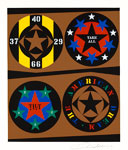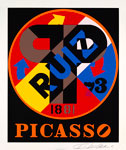THE ARTIST
ROBERT INDIANA
Sigmund Freud use the term dream-work to denote the various activities of the unconscious mind, which sorts through the tumult of experience and gives it symbolic form. The process is an apt metaphor of the creative practice of Robert Indiana, who, during the sixties, was part of the movement known as Pop Art - art that uses the imagery of popular and commercial culture. But Indiana’s references to pinball machines, roadside diners, and highway signs, and the short words and numbers that fill his compositions, are much more than Pop. They are codes of autobiographical meaning. His works are ciphers of his Depression-era childhood and his long climb from anonymity to renown. Dream-work also described Indiana’s critique of the myth of the American Dream.
|



